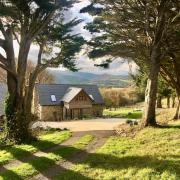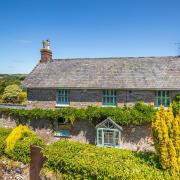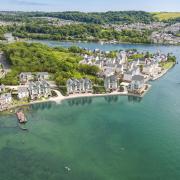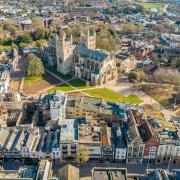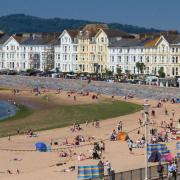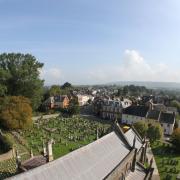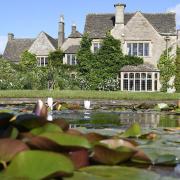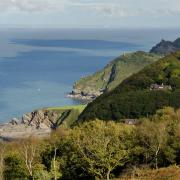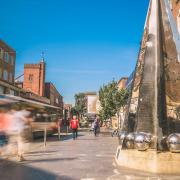The best way to approach Lynton is via Station Hill; rounding the top, just before the road drops down into the town, you catch sight of the cliffs at Countisbury. If you’ve driven across the North Devon countryside, following the road from Barnstaple, this first glimpse of the sea and those dark, towering cliffs is always breathtaking.

The landscape around this part of Devon, the coastline on the edge of Exmoor, is not for the faint-hearted, it challenges and at times has proved devastating to the people who live here, but its beauty and grandeur is undisputed.
It may look daunting, it is daunting, but making the effort to walk up the Countisbury cliffs, from Lynton’s twin town of Lynmouth, down by the sea, is so rewarding. It’s a big climb, Exmoor has the highest coast on British mainland and these cliffs stand at 1,000ft, but you steadily follow the South West Coast Path and can stop to catch your breath and look back at the scene as you go.
One reason why it’s good to attempt the climb is that gives a little understanding as to the effort involved in one of Lynmouth’s most famous historic events.
In 1899 a group of volunteers hauled a lifeboat up and over this hill, at night, as part of a sea rescue operation. A ship was in distress off the shore at Porlock, further along the coast. Stormy weather prevented the Lynmouth lifeboat from launching, so coxswain Jack Crocombe proposed to take the lifeboat overland to launch at Porlock Weir, a 13-mile journey.

Around 100 locals and a team of horses helped haul the Louisa up Countisbury Hill, then 20 men continued over the moor and down another precipitous hill into Porlock. It took 11 hours, but they reached their destination, and got to the stricken ship, and all lives were saved.
The locals who helped haul the Louisa up Countisbury took well-earned refreshment at The Blue Ball Inn. Opposite Countisbury church, this former coaching inn continues to offer relief for weary walkers, perhaps lunch or a pint of locally-brewed ale. With its mishmash of tables, armchairs and little corners to hide in it, and the smell of woodsmoke, the ties with the past are very tangible, especially when sat near the impressive open fireplace.
If you like a good walk why not check out this four mile circular route on Dartmoor?
Just a short walk over the fields behind leads to a complete contrast in landscape. Enter into a world of twisted, weather-worn trees. They may be small in stature, but these trees that cling to the higher parts of the East Lyn river valley feel ancient. Shaped by time and the elements, there’s a feeling of being watched, woodland eyes and nature closing in, as you begin the descent down to the river.
The East Lyn meets Hoar Oak Water at Watersmeet, and the National Trust-owned Watersmeet House , is a welcome place to stop. At one time the house was a fishing lodge, built in 1832 by the Reverend W S Halliday, who also had the nearby country house at Glenthorne and was the son of a wealthy Scottish businessman.
The sound of rushing water pounding over rock, and the dense tree covering rising steeply on all sides is comfortably overwhelming and no matter how many people are down here – it is always a popular spot – it’s one of those rare places where it feels like nature is in command.
The river made its presence felt, with horrifying results, in 1952. Extremely high rainfall on one summer’s night, led to the East Lyn and Hoaroak Water, along with the West Lyn river, breaking their banks, causing a torrent of water along with boulders, some up to 50 tons, to swamp the town of Lynmouth. The statistics from that night are shocking: more than 100 buildings were destroyed, 38 cars were washed out to sea, and 34 people died, including four children.
Lynmouth was rebuilt, with river widening and flood defence work - its appearance changed forever. Walking back along the Watersmeet valley towards the town, it’s hard to picture how this beautiful river must have looked during that stormy night, but huge boulders remain, littering the river bed, making a new landscape.
Salmon and trout thrive in the river’s deep pools, and otters have been spotted by a lucky few. The valley is one of our few temperate rainforests. These rare environments contain deciduous trees of mixed ages in a damp and humid environment, like this river valley. Mosses and lichens envelop the rocks and tree branches and some are extremely rare – at least 53 species in Watersmeet alone.
It takes 400 years to create a temperate rainforest, such is their complexity and they are fragile environments. Despite the majesty and awe-inspiring dominance of tree, rock and river, it perhaps pays to walk gently back along this very precious valley.
Lynmouth has a good range of places serving food and drink. Dating back to the 14th century, The Rising Sun on the harbourside offers great food in a very atmospheric setting. There’s always the fish and chip option, and you can get a takeaway from the Esplanade Fish Bar and sit on the harbour wall. Then there are the tearooms, where you can indulge in a cream tea or, at Lynmouth Bay Café, they can supply you with a packed lunch to take with you on your walk.
More information about the Lynmouth flood can be found at the Flood Memorial Hall which has a permanent free exhibition and a scale model of the village pre-flood, along with many personal accounts of the disaster. It also has an exhibition about the famous lifeboat haul over Countisbury Hill.
The Lynmouth National Park Centre is housed in the former Lynmouth Pavilion along The Esplanade and it has lots of useful information about the town and the local area.
Have you joined the Devon Life Facebook page yet?




